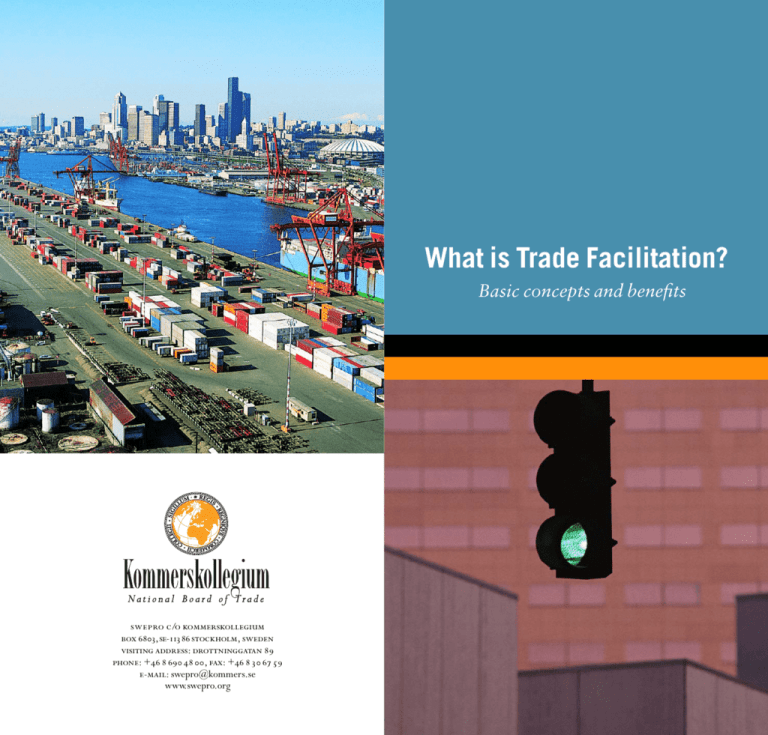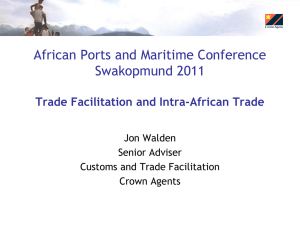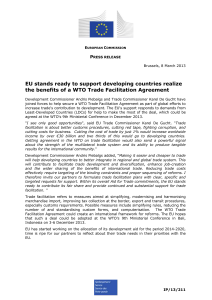Basic concepts - Kommerskollegium
advertisement

What is Trade Facilitation? Basic concepts and benefits swepro c/o kommerskollegium box 6803, se-11386 stockholm, sweden visiting address: drottninggatan 89 phone: +46 8 690 48 00, fax: +46 830 67 59 e-mail: swepro@kommers.se www.swepro.org he volume of international trade has grown rapidly in recent years and trade velocity has become essential. Yet the evident increase and complexity of international trade is often in conflict with present trade procedures, and most countries subject the trade of today to the rules and administrative methods of the past. A study on trade efficiency by the United Nations Conference on Trade and Development (UNCTAD ) showed that an average trade transaction goes through 27 to 30 parties, including brokers, banks, carriers, sureties and freight forwarders. It needs at least 40 documents, not only for government authorities but also for related businesses. Over 200 data elements are typically requested, of which 60 to 70% are re-keyed at least once while 15% are re-typed 30 times. Enormous amounts of time and money are wasted because of outdated trade procedures, hampering business, stifling growth and holding back economic development, particularly in developing countries. Problems contributing towards this include unnecessary and excessive data and documentation requirements, lack of transparency of Customs, excessive clearance times, lack of coordination, and the absence of modern techniques. The importance of ensuring that trade can flow with minimum impediments, with higher security levels and more efficient government control methods, has been the focus of increasing attention. Trade facilitation is a key element in improving the international trading environment. T What is Trade Facilitation – Basic Principles Trade facilitation is a concept directed towards reducing the complexity and cost of the trade transaction process and ensuring that all these activities take place in an efficient, transparent and predictable manner. It relates to a wide range of areas and activities (see Figure 1) such as government regulations and controls, business efficiency, transportation, information and communication technologies and payment systems. Figure 1. THE TRADE CHAIN Examples of possible parties involved in a trade transaction Source: Swepro SHIP BUY Order Prepare • Importer • Exporter • Import Country Authorities • Export Country Authorities PAY Transport Border Crossing • Transporter (Air-, Rail-, Road- and Sea related) • Customs (Import-, Export- and Transit Country) • Inspection Company (PSI) • Health Authorities Payment • Banks • Financial Institutions • Other Intermediaries • Port Management • Other Intermediaries • Agriculture Authorities • Insurance Company • Customs Brokers • Chamber of Commerce • Other Intermediaries • Export/Import Agent • Licensing Agency • Credit Checking Company • Other Intermediaries In order to provide a worldwide accepted and consistent environment for international trade transactions, it is necessary to improve the: • Harmonization of applicable laws and regulations, • Simplification of administrative and commercial formalities, procedures and documents, • Standardization and integration of information and requirements, and the use of technologies so as to exchange this information efficiently, • Transparency, which implies making information on border requirements and procedures available and easily accessible to all interested parties. TRADE FACILITATION PRINCIPLES SIMPLIFICATION TRANSPARENCY HARMONIZATION STANDARDIZATION Trade facilitation takes place at the national, regional and international levels. At the national level, it focuses on harmonizing and simplifying the trade-related structures and procedures within a country. As goods cross international borders moving from one legal and administrative jurisdiction to the other, it is therefore essential to standardize norms internationally. Here lies the important role of the United Nations, the World Trade Organization and other intergovernmental bodies and international business organizations that develop the tools for facilitating trade. Why does it matter? It is difficult to put a price on the benefits of trade facilitation – both for business and for governments. An OECD (Organization for Economic Co-Operation and Development) study concluded that estimates of trade transaction costs range from 2 to 15% of the total transaction value. Trade facilitation is important in its own right – it is an issue with huge potential benefits for business, governments and consumers. Trade facilitation can help reduce the burdens of bureaucracy for companies, broaden market access, increase the participation of small and medium-sized enterprises (SMEs) in international trade, reduce corruption and help all countries obtain benefits from global trade development. It does not limit governments from their sovereign right to set tariffs, to collect Customs revenue or keeping control standards – rather the contrary, it ensures their better administration. Trade facilitation is an instrument to improve public finance by lowering administration costs and freeing resources for re-deployment. It is a win-win situation – all countries stand to gain from facilitating trade. In practical terms, trade facilitation focuses on creating efficiency and reducing costs across the entire trade transaction process. Efficient trade procedures allow goods to travel to customers cheaply, quickly and safely, which has a dynamic effect on competitiveness. Besides being an important element of trade policy, trade facilitation contributes towards development objectives. Investment in manufacturing or increases in volume of trade will not materialize in countries where imports and exports are subject to very lengthy, unpredictable and costly delays. How to make Trade Facilitation happen Any approach in implementing trade facilitation measures should take into account the specific circumstances, needs and capacities of individual countries. Trade facilitation is strengthened by alliances and partnerships with international and local stakeholders in both the public and the private sectors. The key elements are broad multilateral cooperation and dialogue between: • The Government (e.g. Ministries of Trade, Transport, and Finance, including Customs, and related institutions), in designing and implementing national laws and regulations regarding trade and transport; and • The Trading Community (importers and exporters) who can benefit from such solutions in their international trade transactions and service providers (transport operators, banks, insurance companies, etc.) by offering market-oriented trade and transport solutions, and lowering the transaction costs of the flow of goods and money. Facilitation Measures Introducing trade facilitation measures does not have to imply expensive investments in infrastructure or IT-technology or deep structural reforms. Examples of reforms that would increase efficiency, transparency and predictability could be: • The creation of National Trade Facilitation Bodies, in order to achieve the required level of dialogue and cooperation (UN/CEFACT Recommendation No. 4). • Publicizing laws, procedures and other rules affecting import/export, in an easily accessible manner within an agreed timeframe. • The reduction, simplification and standardization of data and documentation required by Customs and other agencies. • The harmonization of regulations of border agencies. • The use of “aligned documents”, in particular the United Nations Layout Key for Trade Documents. • Establishing a right of appeal for traders in matters arising from the activities of border agencies. There should be a timely right of appeal to an agency independent of the border agency. • Establishing “Trade Enquiry Points” where all trade related information is available. • Adjusting the opening hours of border crossings to commercial needs and flexibility to work outside usual business hours. • Improving the coordination between Customs and other control agencies, with the view to achieve a “single window”. However, and according to the experience of many countries, the positive results of trade facilitation will be both greater and faster achieved through the implementation and use of information and communication technology (ICT).






